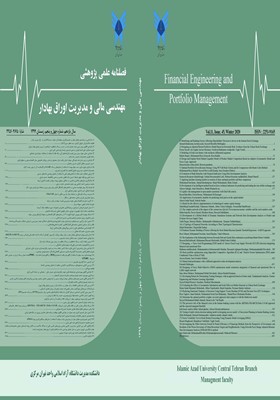بهینهسازی سبد سهام با استفاده از الگوریتم رقابت استعماری (ICA) و الگوریتم ازدحام ذرات (PSO) تحت معیار ریسک ارزش در معرض خطر مشروط (CVaR)
محورهای موضوعی : مهندسی مالیآرزو کریمی 1 * , سارا گودرزی دهریزی 2
1 - گروه ریاضی، دانشکده علوم پایه، دانشگاه آیت اله بروجردی، بروجرد، ایران
2 - گروه ریاضی، دانشکده علوم پایه،دانشگاه آیت الله العظمی بروجردی، بروجرد، ایران.
کلید واژه: سبد سهام, الگوریتم رقابت استعماری, الگوریتم ازدحام ذرات, ارزش در معرض خطر مشروط, مرزکارا,
چکیده مقاله :
انتخاب سبد سهام یک مبحث ویژه در حوزهی سرمایهگذاری است. با توجه به گستردگی انتخابها در بازار سهام یکی از دغدغههای مهم مجموعههای سرمایهگذاری تخصیص بهینهی داراییهاست. ازاینرو اغلب این مجموعهها از مدلهای انتخاب سبد استفاده میکنند. ارزش در معرض خطر مشروط که یکی از مدلهای انتخاب سبد است از برنامهریزی درجه دوم تبعیت میکند. با توجه به اینکه برنامهریزی درجه دوم نیازمند محاسبات وسیعی است، استفاده از الگوریتمهای فرا ابتکاری در حل این مسائل سرعت و دقت محاسبات را افزایش میدهند. هدف این پژوهش حداقل سازی ارزش در معرض خطر مشروط با استفاده از دو الگوریتم رقابت استعماری و ازدحام ذرات است. ازاینرو با استفاده از دادههای ۸۰۰ روز از ۱۲ شرکت پذیرفتهشده در بورس اوراق بهادار تهران در بازه زمانی 5/2/92 تا 28/1/98 به تشکیل سبد پرداخته شد و وزن مربوط به هر سهم در سبد بهینه و میزان ریسک و بازدهی سبدها با استفاده از نرمافزار MATLAB2018 محاسبه شد. سپس با استفاده از امکانات نرم-افزار SPSS به آزمون میانگین تفاوت بین ریسک و بازدهی دو الگوریتم پرداخته شد. نتایج نشان داد که ریسک و بازدهی دو الگوریتم ازنظر آماری تفاوت معناداری ندارند، اما الگوریتم رقابت استعماری در زمان کوتاهتری به جواب بهینه میرسد.
The choice of stock portfolio is a special issue in the field of investment. Given the wide range of options in the stock market, one of the major concerns of investment groups is the optimal allocation of assets. Therefore, most of these collections use portfolio selection models. The conditional value at Risk, which is one of the models of portfolio selection, follows the Quadratic Programming. Given that Quadratic Programming requires extensive computations, the use of metaheuristic algorithms in solving these problems increases the speed and accuracy of computations. The aim of this study is to minimize the Conditional Value at Risk by using two algorithms of Imperialist Competitive Algorithm and Particle Swarm Optimization. Therefore, using 800 days of data from 12 companies listed on the Tehran Stock Exchange in the period of 2/5/92 to 1/28/98, portfolio has been formed, and the weight of each stock in the optimal portfolio and the risk and return of the portfolio has been calculated using MATLAB2018 software. Then, using SPSS software, the average difference between risk and return of the two algorithms was tested.The results showed that the risk and return of the two algorithms were not statistically significant,.
_||_
1) Asgharpour Hossein, Rezazadeh Ali. Determining the optimal stock portfolio using the value-at-risk method. Quarterly journal of applied theories of economics. 2014. Number 4: 118-93.
2) Bayat Ali, Asadi Lida. Stock portfolio optimization: usefulness of birds algorithm and Markowitz model. Journal of Financial Engineering and Securities Management. 2016. No. 32: 85-63.
3) Rezaei Asad-Aleh, Falahati Ali, Soheili Kyomarth. Stock portfolio optimization using three-objective particle aggregation algorithm. Quarterly magazine of applied economic theories. 2017. Number 4: 31-52.
4) Rai Reza, Mohammadi Shapour, Ali Beigi Hedayat. Stock portfolio optimization with mean-half variance approach using harmony search method. Journal of management research in Iran. 1389. Number 3: 128-105.
5) Rajabi Mehsa, Khaluzadeh Hamid. Optimizing and comparing stock portfolios in Tehran Stock Exchange with the benefit of multi-objective evolutionary optimization algorithms. Journal of Financial Research. 2013. Number 2: 270-253.
6) Sajjadi Zainab. Stock portfolio optimization using colonial competition algorithm based on value at risk theory and its evaluation. Master's thesis in the field of financial mathematics. Faculty of Mathematical and Computer Sciences. Sheikh Baha'i University. 1390.
7) Fallahpour Saeed, Asefi Sepehr, Fallah Tafti Sima, Bagheri Kazemabad Mohammad Reza. Optimizing the stock portfolio using the meta-heuristic whale algorithm with the expected drop risk criterion. Quarterly Journal of Financial Engineering and Securities Management. 2017. No. 37: 110-132.
8) Golmakani Hamidreza, Fazel Mehrshad. Constrained portfolio selection using particle swarm optimization. Journal of expert systems along with applications. 2018. No. 38: 8333-8327.
9) Maruti-Sharifabadi Ali, Azizi Shirin, Ahmadi Nastern. Application of Colonial Competition Algorithm (ICA) in portfolio optimization and formation. Investment Knowledge Quarterly. 2014. No. 13: 19-41.
10) Moulai Mohammad Ali, Arash Talebi. Investigating the application of Vanelderm-Mead's innovative-combined genetic algorithm in portfolio optimization. Two quarterly economic essays. 1389. No. 14: 204-171.
11) Neshatizade Laia, Heydari Hassan. Investigating volatility and risk criteria in constrained optimization models using colonial competition algorithm. Econometric Modeling Quarterly 2017. Number 4: 11-35.
12) Nasrullah Zadeh - Kapri Tahereh. Stock portfolio optimization using algorithm (ICA) and value-at-risk model. Master's thesis in financial management, Islamic Azad University, Tehran branch. Faculty of Management. 2014.
13) Babaei, S., Sepehri, M. M.; Babaei, E. (2015). Multi-objective portfolio optimization considering the dependence structure of asset returns, European Journal of Operational Research, Volume 244, Pages 525-539.
14) Cura, T. (2009). Particle swarm optimization approach to portfolio optimization, Nonlinear Analysis: Real World Applications, Volume 10, Pages 2396-2406.
15) Deng, Guang F., Lin. Woo T., & Lo, Chih C. (2012). Markowitz-based portfolio selection with cardinality constraints using improved particle swarm optimization, Expert Systems with Applications, Volume 39, Pages 4558-4566.
16) Kandasamy, H. (2008). Portfolio Selection under Various Risk Measures, Ph.D thesis, Mathematical Sciences, Clemson University.
17) Meghwani, S. S., Thakur, M. (2017). Multi-criteria algorithms for portfolio optimization under practical constraints, Swarm and Evolutionary Computation, Volume 37, Pages 104 - 125.
18) Yan, W., Miao, R., & Li, S. (2007). Multi-period semi-variance portfolio selection: Model and Numerical Solution, Applied Mathematics and Computation, Volume 194, Pages 128-134.
19) Zhu, Hanhong et al (2011). Particle swarm optimization for the constrained portfolio optimization problem, Expert Systems with Applications, Volume 38, Pages 10161-10169.

